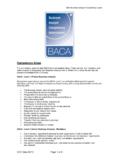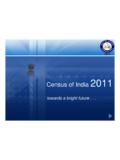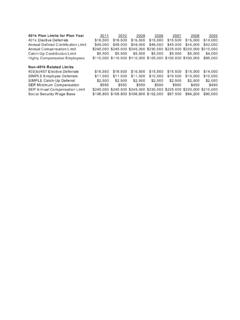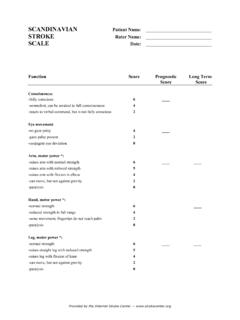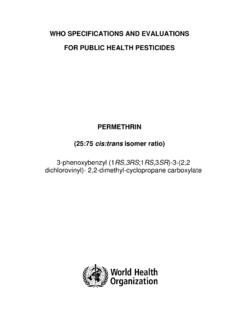Transcription of HANDOUT Breathing and Swallowing 2011
1 Swallowing and Breathing ~. Sharing a Common Connection Doreen Kelly Izaguirre, MA, CCC-SLP. Manager, Internal Staff Development ~ RIC Academy Speech-Language Pathologist, Spinal Cord Injury Program June 2011 . Rehabilitation Institute of Chicago 2. SCI Unit ~ RIC 7th Floor Gym 3. Course Objectives Upon completion of this course, participants will be able to: 1. Describe normal and disordered Swallowing function 2. State the role and importance of upper airway airflow for Swallowing function 3. Discuss the relationship between Breathing and Swallowing 4. Describe how to use the relationships between the respiratory and digestive systems to improve Swallowing function 4. The Swallow Evaluation dysphagia is a major cause of morbidity, mortality and costly disability proper assessment is critical typical choices in the medical setting CSE, FSS, FEES.
2 Must choose the best examination for our patients under the existing constraints of our setting swallow eval of the future must include a closer look at Breathing 6. Cranial Nerves CN V: Trigeminal CN VII: Facial CN IX: Glossopharyngeal CN X: Vagus CN XI: *Spinal Accessory CN XII: Hypoglossal 7. Phases of Swallowing anticipatory phase oral preparation phase oral phase (<1 second). pharyngeal phase (<1 second). esophageal phase (8-20 seconds). These phases are very fluid and recent research highlights the artificiality of separating the Swallowing continuum into isolated phases . (B. Martin-Harris). 8. Common Etiologies of Dysphagia stroke traumatic brain injury other neuromuscular disorders and disease Parkinson's disease Multiple Sclerosis Myasthenia Gravis Amyotrophic Lateral Sclerosis head and neck tumors 9.
3 Common Etiologies of Dysphagia generalized weakness secondary to cardiovascular procedures, other surgery or severe metabolic disorders spinal cord injury tracheostomy tube / mechanical ventilation idiopathic iatrogenic 10. Swallowing Outcomes 11. Whose Turn is it Anyway? Exhale-Swallow-Exhale is the preferred pattern for healthy adults 12. Normal vs. Diseased States What can disrupt the coordinated pattern? Can swallow-respiratory discoordination increase aspiration risk? What do we know about swallow-respiratory coordination of the disordered groups? Parkinson's disease COPD. Cancer Sleep apnea Trach / Vent Aging swallow 13. Are We Inextricably Linked? Do lung volumes play a role? What do we understand about the subglottis?
4 What about pressure? What do we know about the timing of the swallow in the respiratory cycle? How about those lung-thoracic unit recoil forces? 14. All Things to Consider 15. High Risk for Aspiration reduced arousal / alertness reduced responsiveness to stimulation absent swallow response absent productive cough difficulty handling secretions significant reduction in ROM and strength of oral motor and laryngeal movements ? decreased swallow-respiratory coordination 16. Clinical Signs of Aspiration coughing / choking throat clearing wet gurgly vocal quality chest heaving / increased respiratory rate other signs of distress elevated temperature acoustic changes in the lung fields 17. Severe Respiratory Distress diaphoresis and nasal flaring heightened sternomastoid activity recession in suprasternal and supraclavicular spaces tachypnea over the course of a minute intercostal space recession paradoxical motion of the abdomen tachycardia 18.
5 The Blue Dye Test . blue dye placed on patient's tongue at preset intervals patients secretions monitored for presence of blue dye upon suction presence of blue dye in secretions indicates aspiration of patients own secretions advantages no food or liquid presented non-invasive and requires no special equipment can serve as a screening for determining if some patients are appropriate for more formal swallow evaluation disadvantages does not allow for assessment of the effects of consistency does not indicate the cause of aspiration 19. Modified Evan's Blue Dye Test (MEBDT) . food and/or liquids are dyed blue patient's secretions monitored for presence of blue dye upon suctioning advantages allows for assessment of consistency (thick vs.)
6 Thin, etc.). allows for assessment with one-way speaking valve disadvantages validity has been questioned in the research may not identify aspiration that occurs later due to pharyngeal residue if more than one consistency is presented, there is no way of determining which consistency was aspirated What are the other options? 20. Systemic Absorption of Blue Dye 2 critically ill patients with sepsis received enteral feedings with blue dye no. 1. Skin and serum turned green / blue patients died of refractory hypotension and acidosis FD&C Blue No. 1 and related dyes have a toxic effects on mitochondria, suggesting that dye absorptions is harmful recommend judicious use of food dye in patients with sepsis Maloney JP, Halbower AC, Fouty BF et al.
7 Systemic absorption of food dye in patients with sepsis. N Engl J Med 2000 Oct;343(14):1047-8. Maloney JP, Ryan TA, Brasel KJ et al. Food dye use in enteral feedings: a review and call for a moratorium. Nutr Clin Pract 2002 Jun;17(3):140-1. 21. Why Fluoroscopic? measures speed of swallow measures efficiency of swallow defines movement patterns determines if penetration or aspiration occurs when, why, how much examines effectiveness of treatment 22. FSS. examination of treatment strategies by X-ray can impact diet and recovery from dysphagia ~83% of patients receiving a FSS may receive changes in at least 1 of 5 important clinical variables referrals to other specialists swallow therapy compensatory strategies change in mode of nutritional intake diet Martin-Harris B, Logemann JA et al.
8 Clinical utility of the Modified Barium Swallow. Dysphagia 2000;15:136-141. 23. Fluoroscopic Swallow Study Images 24. Fluoroscopic Swallow Study Images 25. Vent Swallowing and Breathing sharing of system changes in timing of airway closure discoordinated pattern of Swallowing and Breathing disruption of normal apneic interval reduced secretion and saliva management reduced respiratory defenses 26. Aspiration Langmore and colleagues found that while dysphagia and aspiration are important risk factors for aspiration pneumonia, they are insufficient to cause pneumonia unless other factors are present. Predictive risk factors for included dependency for feeding and oral care, number of decayed teeth, tube feeding, more than one medical diagnosis, number of medications and smoking.
9 Langmore SE, Terpenning MS, Schork A et al. Predictors of aspiration pneumonia: how important is dysphagia? Dysphagia 1998;13:69-81. 27. Predictors of Aspiration Pneumonia cross-sectional retrospective analysis of nursing home residents N = 102,824. 18 significant predictors of aspiration pneumonia from strongest to weakest Langmore SE, Skarupski KA et al. Predictors of aspiration pneumonia in nursing home residents. Dysphagia 2002;17(4):298-307. 28. Predictors of Aspiration Pneumonia suctioning use UTI. COPD dependence for eating CHF bed mobility presence of tube feeding locomotion bedfast number of medications high case mix index age delirium stroke weight loss Swallowing problems tracheostomy care mechanically altered diet 29.
10 Trach / Vent Population individuals with tracheostomy and receiving mechanical ventilation are among the most ill and medically complex patients prone to aspiration critical to regularly assess these patient in multiple scenarios no single scenario works for all patients every patient is unique 30. Trach / Vent Population flaw in the literature no pre-trach data very complicated subjects that confound the data some studies have shown that 67% of vent patients do NOT. aspirate yet of the 33% that do aspirate, in 82% of those patients the aspiration is SILENT. 31. Course Objectives Upon completion of this course, participants will be able to: 1. Describe normal and disordered Swallowing function 2.
